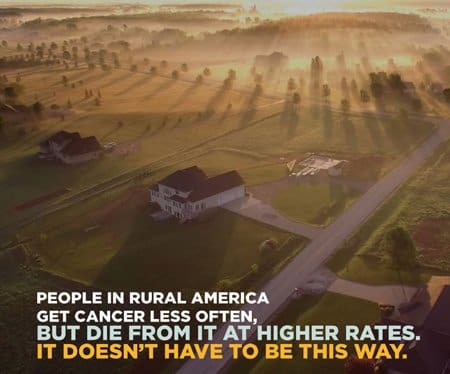New CDC report shows incidence and mortality from colorectal cancer higher in rural America

A new study published in CDC’s Morbidity and Mortality Weekly Report shows slower reduction in cancer death rates in rural America (a decrease of 1.0 percent per year) compared with urban America (a decrease of 1.6 percent per year). The report is part of a series of MMWR studies on rural heath.
The report is the first complete description of cancer incidence and mortality in rural and urban America. Researchers found that rates of new cases for lung cancer, colorectal cancer, and cervical cancer were higher in rural America. In contrast, rural areas were found to have lower rates of new cancers of the female breast and prostate. Rural counties had higher death rates from lung, colorectal, prostate, and cervical cancers.
“While geography alone can’t predict your risk of cancer, it can impact prevention, diagnosis and treatment opportunities – and that’s a significant public health problem in the U.S.,” said CDC Acting Director Anne Schuchat, M.D. “Many cancer cases and deaths are preventable and with targeted public health efforts and interventions, we can close the growing cancer gap between rural and urban Americans.”
In the study, researchers analyzed cancer incidence data from CDC’s National Program of Cancer Registries and the National Cancer Institute’s Surveillance, Epidemiology, and End Results program. Cancer deaths were calculated from CDC’s National Vital Statistics System. Counties were grouped by urbanization and population size.
Key findings from analysis of cancer rates
- Death rates were higher in rural areas (180 deaths per 100,000 persons) compared with urban areas (158 deaths per 100,000 persons). Cancer deaths in rural areas decreased at a slower pace, increasing the differences between rural and urban areas.
- While overall cancer incidence rates were somewhat lower in rural areas (442 cases per 100,000 persons) than in urban areas (457 cases per 100,000 persons), incidence rates were higher in rural areas for several cancers, including those related to tobacco use such as lung cancer and those that can be prevented by cancer screening such as colorectal and cervical cancers.
- While rural areas have lower incidence of cancer than urban areas, they have higher cancer death rates. The differences in death rates between rural and urban areas are increasing over time.
“Cancer – its causes, its prevention, and its treatment – is complicated,” said Lisa C. Richardson, M.D., oncologist and director of CDC’s Division of Cancer Prevention and Control. “When I treat cancer patients, I don’t do it alone – other healthcare professionals and family members help the patient during and after treatment. The same is true for community-level preventive interventions. Partnerships are key to reducing cancer incidence and the associated disparities.”
The CDC researchers also identify a number of proven strategies that can reduce the gaps in new cancer cases and deaths. Read the study to learn more.
We Highlight Successes, Leaders, Best Practices, And Tools That Are Making An Impact In The Nationwide Movement To Reach 80% Screened For Colorectal Cancer.
Do you have a suggestion for a future blog topic? We welcome you to share your suggestions by emailing [email protected].
Blog Policy
Opinions expressed in these blog posts are that of the author and do not represent policies of the National Colorectal Cancer Roundtable or the author’s institution.
Our staff moderate all comments on the 80% Blog. While we do not censor based on point of view, we will delete or edit comments that are offensive or off topic. Click here to view full version.
© 2024 American Cancer Society National Colorectal Cancer Roundtable. All rights reserved.


